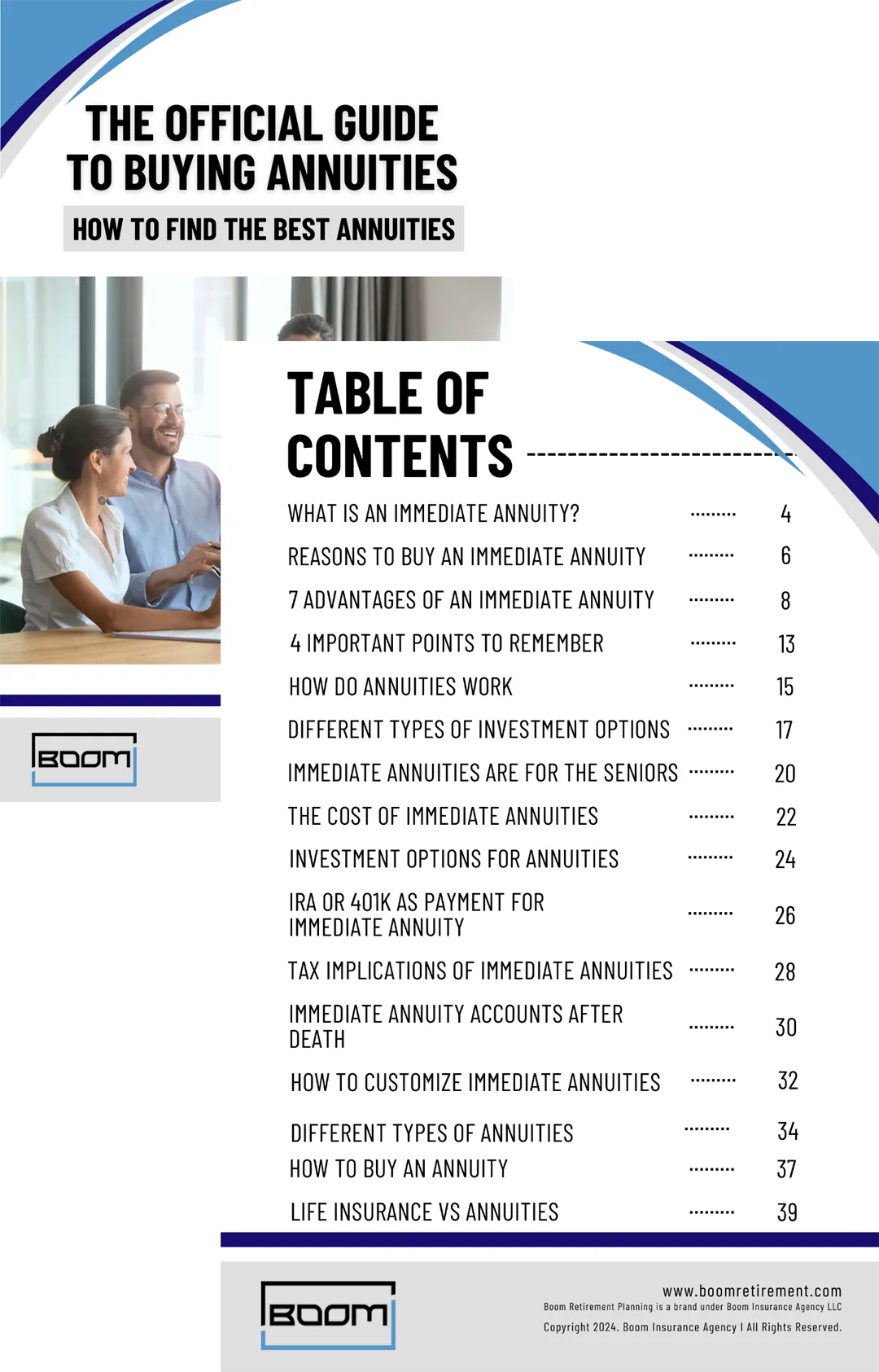
BOOM RETIREMENT SOLUTIONS
Strategies for Boosting Retirement Income

Top Retirement Cash Flow Risks
Why you need this Retirement Toolkit
Will outlive your retirement savings?
Will taxes and inflation erode your Retirement Nest Egg?
Will you head into retirement using an Accumulation Strategy or a Decumulation Strategy?
Will you maintain your lifestyle in a market downturn?
Are you prepared for RMD's and IRMAA?
BOOM RETIREMENT PLANNING
Strategies for Boosting Retirement Income
If You Ask 50 Financial Advisors,
"What is the best way to retire?".
You will get 50 different answers!
That is because despite all their training and certifications,
financial advisors each bring their own perspectives, experiences, and
biases to the table, leading to varied approaches and strategies tailored to their
unique understanding of the market, client needs, and risk tolerance.
Economic Science and Math proves...
There is Only One Optimal Way to Retire
Over 6 Decades of Research Created the 7 Steps Below.
Develop a Plan: Assess your financial situation, retirement goals, income sources and monthly budget for expenses.
Secure Lifetime Income: Consider products like private pensions for guaranteed income.
Maximize Social Security: Optimize benefits by understanding your options; delaying to 67 or 70 can help.
Diversify Investments: Build a balanced portfolio—30% cash value life insurance, 30% lifetime income, 40% growth assets.
Prepare for Health Care Costs: Budget for health expenses, including long-term care, which most seniors will need.
Use Tax-Efficient Strategies: Consider Roth conversions to reduce retirement taxes.
Stay Active and Engaged: Pursue activities for mental, physical, and emotional well-being in retirement.
Our Blog

Comparing Certificates of Deposit and Fixed Annuities: Why a Fixed Annuity Might Be the Better Choice
Comparing Certificates of Deposit and Fixed Annuities: Why a Fixed Annuity Might Be the Better Choice
When it comes to safe investment options, Certificates of Deposit (CDs) and Fixed Annuities often come up as reliable choices. Both offer guaranteed returns and are popular among conservative investors seeking to protect their principal while earning a predictable interest rate. However, despite their similarities, there are key differences between the two that can make one a better choice over the other, depending on your financial goals. In this article, we'll compare a Certificate of Deposit with a 5% interest rate and a Fixed Annuity with a 5.4% interest rate over five years, highlighting why a Fixed Annuity might be the superior option for your investment needs.
Understanding Certificates of Deposit (CDs)
A Certificate of Deposit (CD) is a savings product offered by banks and credit unions. When you purchase a CD, you agree to deposit a certain amount of money for a fixed term, ranging from a few months to several years. In return, the bank pays you a fixed interest rate for the duration of the term. CDs are known for their safety, as they are typically insured by the Federal Deposit Insurance Corporation (FDIC) up to $250,000 per depositor, per insured bank.
Key Features of a Certificate of Deposit
Fixed Interest Rate:
CDs offer a fixed interest rate for the entire term, providing predictable returns.
Term Length:
Terms can range from a few months to several years. In this comparison, we'll consider a 5-year CD with a 5% interest rate.
Early Withdrawal Penalties:
Withdrawing money before the CD matures usually incurs a penalty, which can reduce your earnings.
Safety and Insurance:
CDs are insured by the FDIC, making them a very safe investment option.
No Additional Contributions:
Once the CD is opened, you cannot add more money to it. You must open a new CD to invest additional funds.
Understanding Fixed Annuities
A Fixed Annuity is an insurance product that provides a guaranteed interest rate for a specified period. When you purchase a Fixed Annuity, you pay a lump sum to the insurance company, which in turn promises to pay you a fixed interest rate over the annuity's term. Fixed Annuities are designed to offer stable, predictable returns and are often used as part of a retirement income strategy.
Key Features of a Fixed Annuity
Guaranteed Interest Rate:
Fixed Annuities offer a guaranteed interest rate, which can be higher than that of CDs. In this comparison, we'll consider a 5-year Fixed Annuity with a 5.4% interest rate.
Tax-Deferred Growth:
Earnings in a Fixed Annuity grow tax-deferred, meaning you do not pay taxes on the interest until you withdraw the funds.
Withdrawal Flexibility:
While there may be penalties for early withdrawals, many Fixed Annuities offer some flexibility, such as the ability to withdraw a portion of the funds without penalty after the first year.
Principal Protection:
Fixed Annuities provide principal protection, ensuring that your initial investment is safe.
Lifetime Income Options:
Many Fixed Annuities offer the option to convert the accumulated value into a stream of income for life, providing additional financial security in retirement.
Comparing CDs and Fixed Annuities
1. Interest Rates and Returns
Certificate of Deposit (CD):
A 5-year CD with a 5% interest rate offers predictable returns over the term. For an initial investment of $10,000, you would earn $500 per year, resulting in a total interest of $2,500 over five years.
Fixed Annuity:
A 5-year Fixed Annuity with a 5.4% interest rate provides higher returns compared to the CD. For the same initial investment of $10,000, you would earn $540 per year, resulting in a total interest of $2,700 over five years.
2. Tax Treatment
Certificate of Deposit (CD):
Interest earned on a CD is taxable in the year it is earned. This means you will pay taxes on the interest each year, which can reduce your net returns, especially if you are in a higher tax bracket.
Fixed Annuity:
Earnings in a Fixed Annuity grow tax-deferred, meaning you do not pay taxes on the interest until you withdraw the funds. This allows your investment to compound more efficiently over time, potentially resulting in higher net returns.
3. Early Withdrawal Penalties
Certificate of Deposit (CD):
CDs typically impose penalties for early withdrawals, which can significantly reduce your earnings. The penalty amount varies by institution but often involves forfeiting a portion of the accrued interest.
Fixed Annuity:
Fixed Annuities also have penalties for early withdrawals, usually in the form of surrender charges. However, many Fixed Annuities offer some flexibility, such as allowing a portion of the funds to be withdrawn penalty-free after the first year.
4. Principal Protection and Safety
Certificate of Deposit (CD):
CDs are insured by the FDIC up to $250,000 per depositor, per insured bank, providing a high level of safety for your principal.
Fixed Annuity:
Fixed Annuities offer principal protection through the insurance company. While they are not FDIC-insured, they are backed by the financial strength of the issuing insurer and regulated by state insurance departments. Additionally, state guaranty associations provide a safety net, although coverage limits vary by state.
5. Flexibility and Additional Contributions
Certificate of Deposit (CD):
CDs do not allow additional contributions once opened. If you want to invest more money, you must open a new CD.
Fixed Annuity:
Fixed Annuities often allow additional contributions during a specified period, providing more flexibility to grow your investment.
6. Income Options
Certificate of Deposit (CD):
CDs do not offer income options. At maturity, you can either withdraw the funds or reinvest in a new CD.
Fixed Annuity:
Fixed Annuities provide various income options, including the ability to convert the accumulated value into a lifetime income stream. This feature is particularly valuable for retirees seeking a reliable source of income.
Why a Fixed Annuity Might Be the Better Choice
While both CDs and Fixed Annuities offer safety and predictable returns, Fixed Annuities provide several advantages that make them a superior choice for many investors.
1. Higher Interest Rate
In this comparison, the Fixed Annuity offers a 5.4% interest rate, which is higher than the 5% rate provided by the CD. Over five years, this higher rate results in greater total earnings, making the Fixed Annuity a more attractive option for maximizing your investment returns.
2. Tax-Deferred Growth
The tax-deferred growth feature of Fixed Annuities allows your investment to compound more efficiently over time. Unlike CDs, where interest is taxed annually, the interest earned in a Fixed Annuity is not taxed until you withdraw the funds. This can result in higher net returns, particularly for investors in higher tax brackets.
3. Flexibility and Additional Contributions
Fixed Annuities offer more flexibility compared to CDs. Many Fixed Annuities allow additional contributions, providing an opportunity to grow your investment further. Additionally, Fixed Annuities often offer more lenient withdrawal terms, such as penalty-free withdrawals of a portion of the funds after the first year.
4. Lifetime Income Options
One of the most significant advantages of Fixed Annuities is the option to convert the accumulated value into a lifetime income stream. This feature provides a reliable source of income in retirement, reducing the risk of outliving your savings. CDs, on the other hand, do not offer any income options beyond the maturity of the term.
5. Principal Protection and Safety
While CDs are insured by the FDIC, Fixed Annuities offer principal protection through the financial strength of the issuing insurance company and state guaranty associations. This provides a high level of safety for your investment, similar to that of CDs.
6. Higher Net Returns
Due to the combination of a higher interest rate, tax-deferred growth, and the potential for additional contributions, Fixed Annuities can provide higher net returns compared to CDs. This makes Fixed Annuities a more attractive option for investors seeking to maximize their investment growth while maintaining a high level of safety.
Conclusion: Why a Fixed Annuity Might Be the Better Choice
In summary, while both Certificates of Deposit and Fixed Annuities offer safety and predictable returns, Fixed Annuities provide several distinct advantages that make them a superior choice for many investors. The higher interest rate, tax-deferred growth, flexibility in contributions, lifetime income options, and principal protection make Fixed Annuities an excellent option for those looking to secure their financial future and maximize their investment returns.
If you are considering your investment options, consulting with a retirement specialist can help you determine whether a Fixed Annuity is the right choice for you. With the right information and guidance, you can make informed decisions that enhance your financial security and provide peace of mind in your retirement years.
Taxation can play a substantial role in determining
the overall value of your retirement portfolio
How are your current retirement income sources taxed?
Social Security
Qualified Accounts
Non-Qualified Accounts
Social Security is a federal government program in the United States that provides financial benefits to eligible individuals, primarily retirees, disabled individuals, and their families. It is funded through payroll taxes collected under the Federal Insurance Contributions Act (FICA) and the Self-Employment Contributions Act (SECA).
Key components of Social Security include:
Retirement Benefits: These benefits are available to workers who have paid into the Social Security system through payroll taxes during their working years. Individuals can start receiving reduced retirement benefits as early as age 62, but full benefits are available at the full retirement age, which varies depending on the year of birth. Delaying benefits beyond full retirement age can increase the monthly benefit amount.
Disability Benefits: Social Security Disability Insurance (SSDI) provides benefits to individuals who are unable to work due to a qualifying disability. To be eligible, individuals must have a sufficient work history and meet specific medical criteria.
Survivor Benefits: These benefits are paid to the surviving spouses, children, or dependents of deceased workers who paid into the Social Security system. The amount of the benefit depends on the deceased worker's earnings record.
Supplemental Security Income (SSI): Although administered by the Social Security Administration, SSI is a separate program funded by general tax revenues (not Social Security taxes). It provides financial assistance to elderly, blind, or disabled individuals with limited income and resources.
Social Security is a critical component of retirement planning for many Americans, providing a safety net to ensure a basic level of income in retirement, during periods of disability, or after the death of a family member.
Social Security benefits may be taxed based on your combined income, which includes adjusted gross income, nontaxable interest, and half of your Social Security benefits. Depending on your income level, up to 85% of your benefits could be subject to federal income tax.
A qualified account is a type of retirement savings account that offers tax advantages, typically regulated by the IRS under specific sections of the tax code. Contributions to qualified accounts are often tax-deferred, meaning that contributions are made with pre-tax dollars, reducing the individual's taxable income in the year of the contribution. Taxes on contributions and investment earnings are deferred until withdrawals are made, usually in retirement.
401(k) plans
403(b) plans
457 plans
Traditional IRAs
SEP IRAs
SIMPLE IRAs
Self Directed IRAs
Pensions
Annuities
Withdrawals from these accounts are generally subject to income tax, and there may be penalties for early withdrawals before a certain age (usually 59½). Additionally, qualified accounts are subject to Required Minimum Distributions (RMDs) once the account holder reaches age 73 (if born before 1960).
Required Minimum Distributions (RMDs) are the minimum amounts that retirees must withdraw annually from their tax-deferred retirement accounts, such as traditional IRAs and 401(k)s, starting at age 73 (as of 2023). The amount of the RMD is calculated based on the account balance and the account holder's life expectancy. Failing to take RMDs can result in significant tax penalties, including a hefty excise tax on the amount that should have been withdrawn.
A non-qualified account is a type of investment account that does not have the same tax advantages or restrictions as qualified retirement accounts. Unlike qualified accounts, contributions to non-qualified accounts are made with after-tax dollars, meaning there's no tax deduction for contributions.
Examples of non-qualified accounts include:
Brokerage accounts
Mutual fund accounts
Certificates of deposit
Savings accounts
Roth IRA
Cash Value Life Insurance
Annuities
These accounts are often used for general savings and investments outside of retirement, offering more flexibility in terms of contributions and withdrawals, but without the tax advantages of qualified accounts.
The exception is the Roth IRA in which the principal, interest, earnings and dividends are all tax-free. Roth IRAs are also not subject to RMD's.
A Roth conversion is the process of transferring funds from a Qualified retirement accounts into a Roth IRA (Non-Qualified Account). The converted amount is subject to income tax in the year of the conversion, but future withdrawals from the Roth IRA are tax-free, provided certain conditions are met. This strategy is often used to reduce taxable income in retirement and to avoid required minimum distributions (RMDs).
Books for Retirees and Soon-To-Bes
Choose Your Book
Retirement Income


Tax Strategies




Long Term Care



Boom Final Expense is a brand under Boom Insurance Agency LLC
©Copyright 2023| Boom Insurance Agency. All Right Reserved

Boom Retirement Planning is a brand under Boom Insurance Agency LLC
©Copyright 2024| Boom Insurance Agency. All Right Reserved





